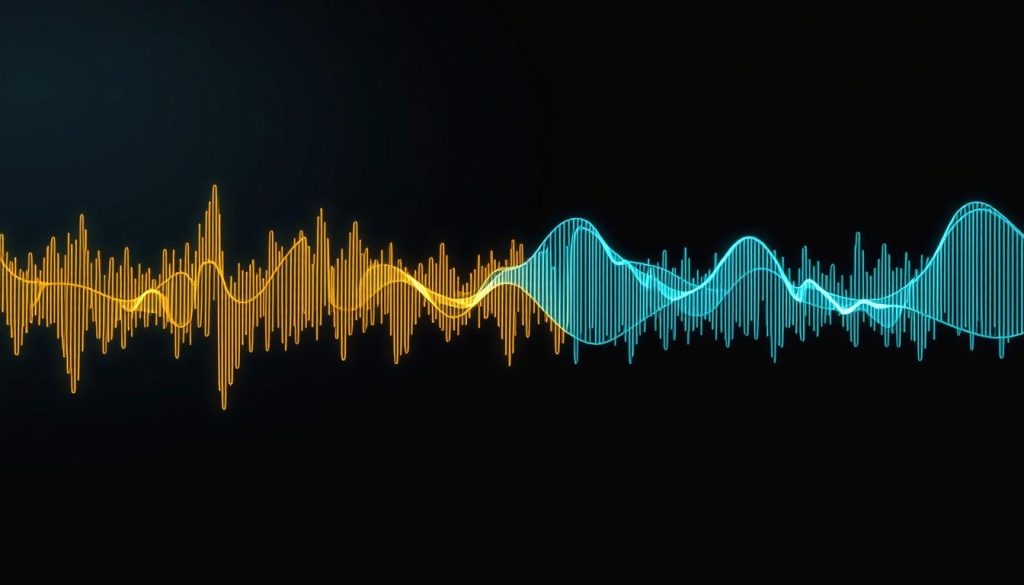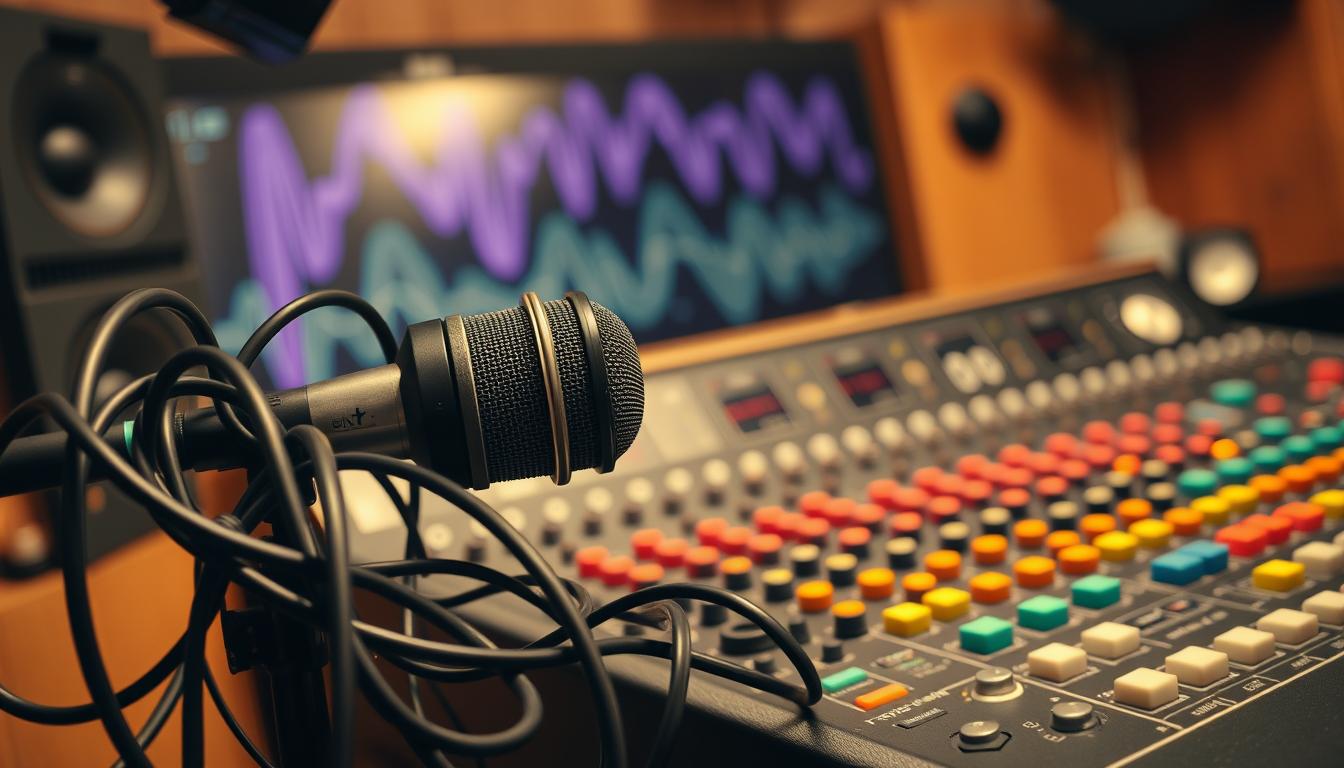As a content creator, I know how key high-quality audio is for great videos. Using an external mic is a good start. But, there are still issues that can mess up your audio. This article will cover the main audio problems and give you ways to fix them for better recordings.
Recording audio can be tricky. Things like where you put your mic, the room’s sound, and how you speak can change the audio quality. Knowing and fixing these issues can make your videos better and keep viewers watching.
Next, I’ll talk about different audio problems. These include issues like a low sound, the proximity effect, and getting rid of room and background noise. We’ll also look at how to handle harsh sounds, sibilance, and distortion. By the end, you’ll know how to beat these audio problems and make your recordings stand out.
Bassy Sound and the Proximity Effect
A common mistake in recording is getting a bassy sound. This happens when a microphone is close to the sound source. It boosts low frequencies, making the sound too deep.
To fix this, we must spot these bassy sounds and adjust the mic’s position.
Identifying Bassy Recordings
First, notice if your recordings sound boomy or muddy. This means the low frequencies are too strong. If you hear this, the proximity effect might be the cause.
Adjusting Microphone Distance
To lessen the bass, move the mic away from the sound source. Aim for a distance of 6-12 inches. This reduces the proximity effect and makes the sound more balanced.
Keeping the mic at a steady distance also stops volume changes. By fixing these bassy sounds, your recordings will sound much better. Remember, where you place the mic is crucial for a professional sound.
Minimizing Room and Background Noise
Getting clean audio in your recordings can be tough, especially with room sounds and background noise. But, with the right methods and tools, you can make your audio much clearer and better.
Using Cardioid Microphones
Using a cardioid microphone is a great way to cut down on background noise. These mics are made to catch sound from in front and ignore sounds from the sides and back. Place the mic near the sound source and point it at the speaker. This makes your recording focused and less affected by room sounds and noise around you.
Soundproofing Your Recording Environment
Choosing the right microphone is just part of the solution. Making your recording space soundproof also helps a lot. You can do this by adding acoustic panels, foam, or sound-absorbing materials to your walls, ceiling, and floor. These things stop unwanted sounds from bouncing back, giving you a quieter space for recording.
By using a cardioid microphone and making your space soundproof, you can greatly reduce background noise and room sounds. This makes your recordings clear, sharp, and free from unwanted noises.
recording errors: Tackling Vibrations and Rumbles
As a pro in audio, I’ve found that unwanted noise from vibrations and rumbles is common in home recordings. These sounds can really hurt your audio’s quality. So, it’s key to fix them. Luckily, there are ways to lessen these problems.
One easy step is to make sure your mic stand isn’t touching the floor. This helps keep your mic away from floor vibrations that turn into low rumbles. Using a shock mount can also help keep these vibrations away from your mic.
Some mics have filters or low-cut features to get rid of low sounds. Checking what your mic can do can really help fight vibration noise and rumbles.
It’s also vital to control the area around your mic to avoid these errors. By stopping vibrations and using the right isolation, you can make your audio sound much better. This way, you can get a pro-quality sound.
Dealing with Harsh Plosives and Sibilance

Recording clear audio can be tough, especially with plosive and sibilant sounds. Plosives, like the “p” and “b” sounds, can be loud and distort your recording. Sibilance, the harsh hissing of “s” and “z” sounds, can make your audio unpleasant. But, you can fix these issues with the right techniques to get great vocal recordings.
Understanding Plosives and Sibilance
Plosive sounds happen when you say words starting with “p” or “b” and push out air. This can overload your microphone, causing distortion. Sibilance is the harsh hissing from “s” and “z” sounds. It makes your audio sound bad and uncomfortable for listeners.
Using Pop Filters and Microphone Positioning
- Get a pop filter – a mesh screen between your mouth and the microphone. It softens the air from plosive sounds, keeping them from overwhelming the mic.
- Change your microphone’s position. Pointing the mic away from your mouth can lessen sibilance. Try different angles to find the best one.
- Work on your speaking technique. Speak to the side of the mic instead of right into it to control plosives and sibilance better.
| Technique | Impact on Plosives | Impact on Sibilance |
|---|---|---|
| Pop Filter | Reduces | No impact |
| Off-Axis Mic Positioning | No impact | Reduces |
| Speaking Across Mic | Reduces | Reduces |
Understanding plosives and sibilance and using the right tools and techniques can help you get clean, professional recordings. With practice, you’ll become great at controlling your microphone.
Preventing Distortion and Clipping
As an audio enthusiast, I’ve faced the frustration of distortion or clipping in recordings. These issues can make your audio sound bad and hard to listen to. But, there are easy steps to take to avoid these problems and get clean, high-quality audio.
Managing your gain and input levels is key. Distortion happens when the audio signal is too strong for your device. To stop this, I adjust the gain on my microphone or audio interface. This keeps the signal from getting too loud. Using a limiter is also helpful. It cuts down the loudest parts of the signal, keeping everything safe.
Gain staging is also crucial. It means balancing the levels from the microphone to the final mix. This helps prevent distortion and keeps the sound clear and strong. It might take some practice, but getting good at gain staging is important for quality audio.

